
ISRO Sets Up Station in Ladakh to Simulate Life on Moon & Mars
In a groundbreaking initiative, the Indian Space Research Organisation (ISRO) has established the Himalayan Outpost for Planetary Exploration (HOPE) in Ladakh’s Tso Kar Valley. This strategically located facility is designed to simulate the harsh conditions found on the Moon and Mars, allowing scientists to test life-support systems for future lunar and Martian missions. The valley was chosen for its unique environment, which bears striking similarities to the Martian landscape.
The HOPE station is a significant step forward in India’s ambitious space exploration plans, with the ultimate goal of sending humans to the Moon and Mars in the near future. The station will be operational for a period of 10 days, from August 1-10, during which time two crew members will conduct various tests to assess the feasibility of sustaining human life in such extreme environments.
Why Ladakh?
The Tso Kar Valley in Ladakh was chosen for the HOPE station due to its remarkable similarity to the Martian environment. The valley is characterized by high UV radiation, low atmospheric pressure, extreme cold, and saline permafrost – all of which are similar to the conditions found on Mars. This makes it an ideal location for testing the life-support systems that will be required for future Martian missions.
The extreme conditions in Ladakh also pose a significant challenge for the crew members who will be undertaking the tests. They will have to contend with temperatures as low as -40°C, high winds, and limited visibility – all of which will simulate the harsh conditions that astronauts may encounter on the Moon and Mars.
What to Expect
During the 10-day simulation mission, the two crew members will be tasked with testing various life-support systems, including air, water, and food supply. They will also have to deal with the psychological challenges of living in isolation for an extended period, which is a critical aspect of long-duration space missions.
The crew members will be equipped with specialized equipment and clothing to ensure their safety and comfort during the simulation. They will also have to follow a strict routine, which will include regular medical checks, physical exercise, and mental health assessments.
Significance of the HOPE Station
The HOPE station is a significant milestone in India’s space exploration program, as it marks the first time that the country has undertaken a simulation mission to test life-support systems for lunar and Martian missions. The success of this mission will pave the way for the development of more sophisticated life-support systems that will be required for future human missions to the Moon and Mars.
The HOPE station is also a testament to India’s commitment to space exploration and its desire to push the boundaries of human knowledge. With this initiative, ISRO is demonstrating its capability to conduct complex scientific experiments in challenging environments, which will be essential for future space missions.
Conclusion
The establishment of the HOPE station in Ladakh’s Tso Kar Valley is a significant achievement for ISRO and a major step forward in India’s space exploration program. The simulation mission will provide valuable insights into the challenges of sustaining human life in extreme environments, which will be critical for future lunar and Martian missions.
As the world continues to push the boundaries of space exploration, India is emerging as a major player in the global space community. With the success of the HOPE station, ISRO is demonstrating its capability to conduct complex scientific experiments in challenging environments, which will be essential for future human missions to the Moon and Mars.
Source:






